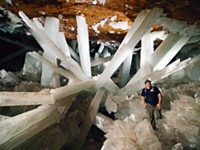Advertisement
Grab your lab coat. Let's get started
Welcome!
Welcome!
Create an account below to get 6 C&EN articles per month, receive newsletters and more - all free.
It seems this is your first time logging in online. Please enter the following information to continue.
As an ACS member you automatically get access to this site. All we need is few more details to create your reading experience.
Not you? Sign in with a different account.
Not you? Sign in with a different account.
ERROR 1
ERROR 1
ERROR 2
ERROR 2
ERROR 2
ERROR 2
ERROR 2
Password and Confirm password must match.
If you have an ACS member number, please enter it here so we can link this account to your membership. (optional)
ERROR 2
ACS values your privacy. By submitting your information, you are gaining access to C&EN and subscribing to our weekly newsletter. We use the information you provide to make your reading experience better, and we will never sell your data to third party members.
Geochemistry
Giant crystals in Mexican cave face dehydration
Water loss from the gypsum crystal surfaces is a primary degradation pathway
by Emma Hiolski, special to C&EN
June 27, 2018

In a cave below a mountain in the Naica mine of Chihuahua, Mexico, gypsum crystals have grown as big as trees. But researchers now report that loss of water may damage the crystal surfaces (Cryst. Growth Des. 2018, DOI: 10.1021/acs.cgd.8b00583). By learning more about the gigantic crystals’ degradation, the scientists hope to better preserve them for generations to come.
The crystals—a form of gypsum called selenite (CaSO4∙2H2O)—took up to a million years to develop within a water-filled, magma-heated cave 300 m below the Earth’s surface. By the time the Cave of Crystals was discovered in 2000, nearby mining activity had already drained away the water.
María Elena Montero-Cabrera of the Center for Research in Advanced Materials and her colleagues wanted to learn how the new conditions in the cave might affect the crystals. They put fragments of a large cave crystal under 16 distinct sets of conditions that varied the exposure to four different atmospheres, two different temperatures, and the presence or absence of water.
The team expected that carbon dioxide exposure would cause calcium carbonate to form on the crystal surface, Montero-Cabrera says. However, both infrared spectrometry and grazing incidence X-ray diffraction analysis revealed no detectable calcium carbonate. Instead they found bassanite (CaSO4∙½H2O), a dehydrated form of gypsum crystal. This conversion could, over many years, cloud and scar the crystal surfaces by creating pits and flakes.
The dehydration occurred primarily in environments that did not include water. However, Montero-Cabrera points out that the team designed the degradation scenarios to be harsher than the actual cave environment, so natural crystal dehydration likely occurs at a slower rate.




Join the conversation
Contact the reporter
Submit a Letter to the Editor for publication
Engage with us on Twitter